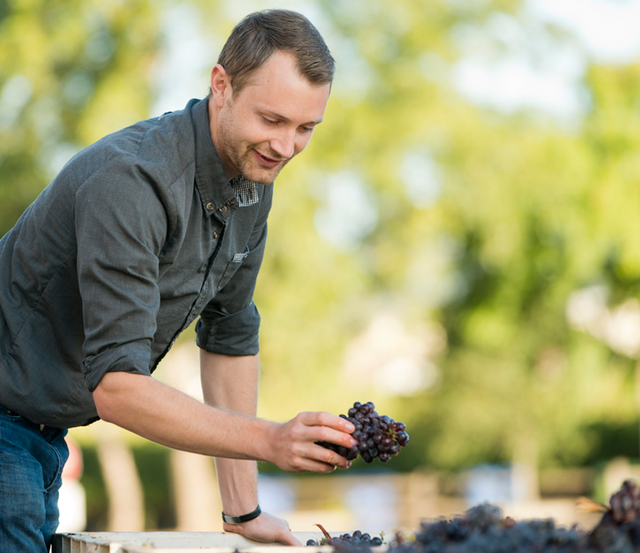Harvest decision 2017: A ripe Cabernet Sauvignon in Napa “should be worth the wait!”
We discuss a preliminary analysis of the 2017 vintage effect on berry ripening dynamics. Our main conclusions are synthesized in this short summary below. If you are interested in the rationales and discussion points, please scroll down after the picture.
SUMMARY
Context:The rate of heat accumulation higher than usual throughout the season has imposed a decoupling of pulp maturation vs. other fruit compartments (like skin and seeds). This phenomenon should not be a surprise. In fact, decoupling of color from sugar accumulations during fruit ripening is perfectly well aligned with early findings on fruit maturation response to temperature warming.
Conclusion: if you want to harvest cabernet sauvignon in Napa in 2017 and if you can afford to postpone harvest until after sugar loading stops, there is some rewards to be expected through the positive effect than an extra color gain may have on your wine composition. More color will boost not only wine color density but also increase tannins extractability as recently demonstrated by Australian researchers. Over the next few days, ability to keep the fruit longer on the vine is going to become increasingly dependent upon microclimatic conditions and their deleterious effect on berry volume loss, cell walls integrity and aroma profile variations. The good news: at this stage of the season, day length is shortening fast and there is no more severe heat wave predicted for the next few days…

Photo by: Kelly McManus/V. Sattui Winery
RATIONALES AND DISCUSSION
Don’t be surprised if your fruit does not taste ripe. 2017 more than the previous 3 years has been marked by a high frequency of heat spikes in Napa. Over the entire Napa valley we have observed on average the highest maximal daily temperatures ever recorded since 2014. This seasonal feature, unique to 2017 vintage in Napa, leads to this counterintuitive trend, which is confirmed by numerous winemakers today. “Despite a similar level of heat accumulation fruit does not taste “ripe” yet for harvest” style="font-size: 16px;"> ... and this is not what you may have expected considering heat accumulation profile.
2017: Paradoxical but logical. Despite having been the rainiest year on record - in Napa,valley average total amount of winter rainfall is greater than 1997! - and despite a higher number of cloudy days early season, 2017 has accumulated an amount of growing degrees days similar to the previous 3 vintages. At some later point of the season heat accumulation must have been faster to compensate for the initial delay! What is the physiological effect of faster heat accumulation rate on fruit ripening dynamics?
2017: SLOWER AND FASTER. A number of cloudy days higher than usual caused an initial delay in heat accumulation profile at the start of the season. In turn, a slight delay in reaching the initial stages of plant development was observed (like budbreak). As of September 10, the initial delay was compensated, due to a faster heat accumulation rate in 2017 during the season, compared to 3 previous seasons. Since June, the frequency of heat wave has been higher than usual compared to the last 3 years. It is interesting to observe that on average the level of vine water deficit measured via sap flow has been comparable to the previous 4 years across multiple and contrasted sites within the valley. Even if a greater leaf area was developed, a surplus of vine transpiration induced a similar level of water deficit in many places.
Take home: as no severe water or nitrogen deficit was observed earlier, it looks like the 2017 vintage has accumulated an amount of heat similar with recent years. Thus, one could have expected fruit ripening to occur at a similar rate. However, because the time profile of heat accumulation was “more jittery” - (slower and then faster than usual) , ripening dynamic is different for the different berry compartments. The direct effect on fruit composition is a latency in ripening profile. By being exposed to temperatures higher than usual, berry ripening time profile was modified. In particular, berry skin ripening dynamic is more disconnected from pulp ripening profile. A practical confirmation of this “ripening asynchrony” is corroborated by our statistical results across multiple sites showing that
- berry volume or sugar amount per berry for a same calendar date is lower than 2016
- a wider gap exists between :
- the timing when sugar accumulation in the pulp reaches its maximal value (which comes first)
- the timing when peak color in the skin reaches its maximal value (which comes later)
The general climatic and physiological trends measured during the 2017 vintage in Napa suggest that, even if active sugar loading (see sugar loading article) in the pulp has stopped, there is still some wait until the maximal amount of skin coloration reaches its highest value. If you like color, 2017 harvest is worth the wait in Napa.